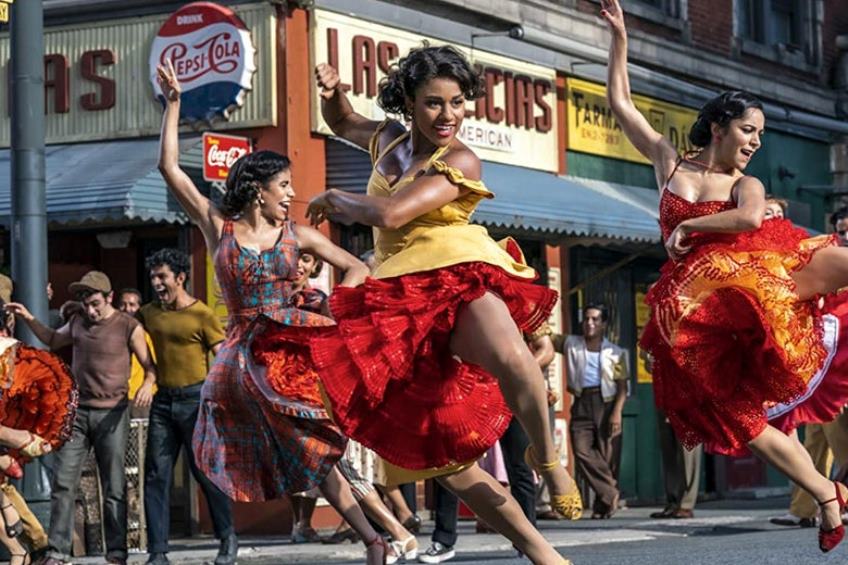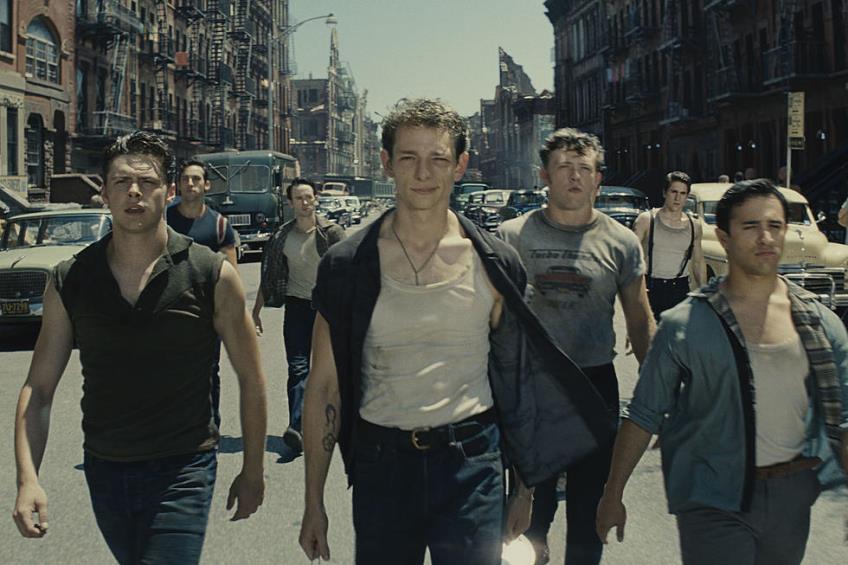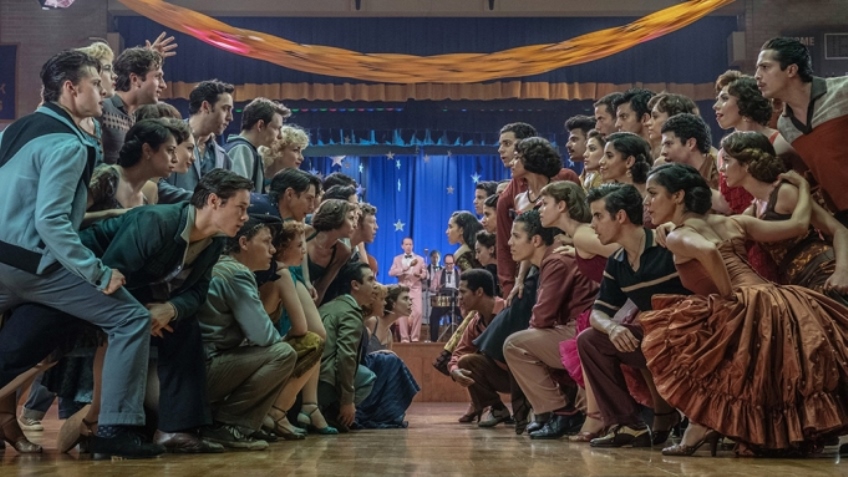Joyce Glasser reviews West Side Story (December 10, 2021) Cert 12A, 156 mins.
There is probably only one director in the world with the box office track record, critical acclaim, personal status, contact list, backing and ambition to tackle a remake of West Side Story. The 1957 Broadway play was a collaboration of inspired geniuses: director and choreographer Jerome Robbins, composer Leonard Bernstein, lyricist Stephen Sondheim and playwright Arthur Laurents tackling the original, gritty story of gang warfare, yet updating the familiar appeal of Romeo & Juliet. The play was not the instant hit but the film (co-directed by Robert Wise and Sondheim) won 10 Academy Awards, was 1961’s highest grossing film and deemed “culturally, historically, or aesthetically significant” by the Library of Congress.
Steven Spielberg, who turns 75 next week, had his work cut out for him, particularly as he had never shot a musical before. With a screenplay by New York City born Tony Kushner, creator of the “outsider” musicals Angels in America and Caroline or Change, jaw-dropping choreography by New York City Ballet’s choreographer Justin Peck, production design by Adam Stockhausen (The Grand Budapest Hotel) casting director Cindy Tolan’s tough brief, and Gustavo Dudamel conducting the New York Philharmonic Orchestra, Spielberg has given us a fantastic adaptation that does justice to the late Stephen Sondheim, who was consulted during the production.
Young Puerto Rican Sharks and second-generation European immigrant Jets are engaged in territorial gang warfare which the police are helpless to control. Teenager Maria goes to a dance with her older brother Bernardo and his girlfriend Anita where she is supposed to dance with Chino, here, an accountant with a future. The dance is organised by the city to broker peace in a social setting, but a chance romantic encounter leads to a killing spree of tit for tat murders. Maria meets Tony, a former Jet, and it is “some enchanted evening” all over again when their eyes lock.

In the update, while respecting the original film, Kushner and Spielberg made some fortuitous changes to give the film the context and authenticity today’s audiences expect, and the film needs. The action is set in summer of 1957 when the controversial Robert Moses (the much-maligned Commissioner of Public Works) was beginning slum clearance in the post WWII Puerto Rican enclave of San Juan Hill and neighbouring Lincoln Square where descendants of 19th century European immigrants lived.
Discrimination against the hardworking, newly arrived Puerto Ricans was rife and is reflected in the gang warfare between the Puerto Rican Sharks and the less industrious white European-American Jets, some of whom, like Tony (Ansel Elgort) have prison records. The filmmakers added one song, not in the original, to stress the Puerto Rican’s pride in their roots, La Borinqueña, the territory’s first National Anthem, the other now being the Star-Spangled Banner.
The prologue begins with Bernstein’s famous whistling sound and is here set in the rubble of demolished homes as the alto sax, flute, and piccolo are gradually joined by the trumpet, oboe, percussion, horn, and clarinet floating over what is today Lincoln Centre, home of the Metropolitan Opera and, ironically, The New York Philharmonic.
The next major change is in the casting. Apart from the police, they are young (many of the original film’s cast were in their thirties) and all had to be able to act, sing and dance to a professional standard (many of the original cast, including Tony and Maria, were dubbed). Here, while the music is pre-recorded, the actors sing, and most pull it off sensationally. Elgort (best known for the weepie The Fault in Our Stars, and the Divergent series) is given one of the most challenging and breath-taking pieces of choreography in the film, in the song Cool where he and Riff (Mike Faist) argue over a gun atop a rickety wood pier with planks missing.
Moreover, the Sharks all had to be Latinx, and, the main roles, Spanish speaking, a requirement that launched a challenging and far-reaching talent search. The search uncovered the find of the year, newcomer, 18-year-old New Jersey High School student Rachel Zegler. Comparisons with tennis star Emma Raducanu are obvious, not only in Zegler’s talent and overnight stardom, but in their ages, ordinary lifestyles and physical appearances. Zegler owns the screen, like a seasoned pro and her acting is nearly as good as her voice.

Bernardo is now a talented boxer, who, if it were not for his destructive machoism and fury at the idea of his little sister dating a Jet, could have been a contender. David Alvarez is no match for George Chakiris (who won an Oscar), but when he starts dancing (he was one of three of the original Billy Elliots on Broadway) he and Ariana DeBose’s Anita are fabulous. Their dance at the gym scenes and America are so sensational that you want to see them all over again. A Boy Like That, DeBose’s scene with Zegler, when Anita sees Tony, who killed her Bernardo, slipping out of Maria’s bedroom window, is electrifying. Another stand-out number, arguably the best in the film, for the sheer brilliance of the lyrics, is Officer Krupke sung by a group of Jets who, left locked in a police station, perform a mock re-enactment of a juvenial delinquent’s progress through the court system.
The film is not perfect. You can see why Elgort was chosen, not only for his proven teen weepie reputation and looks, but because he can really sing – and dance passably. The problem is not only that he does not look tough enough to have been a gang leader, but that the chemistry with Zegler relies too much on the staging and music for the sparks. Another problem is the decision to give 89-year-old Rita Moreno (who won an Oscar for Anita and is here given a new role, as the late Doc’s widow who houses in the drugstore) Maria’s song Somewhere at the end.
It is touching to see Moreno in the film, bridging the 62-year-divide, and suggesting the continuity of racial strife on our city streets. But giving Moreno this song deprives Maria, and the film, a song – and a tearjerker at that – at the end. When Tony is dying, Maria should reprise her hopeful duet with Tony, “We’ll find a new way of living, We’ll find a way of forgiving.” But now, when she sings, “hold my hand and we’re halfway there,” she is referring to death, the only place in which they can be reunited. Somehow, my eyes were dry at the end.




